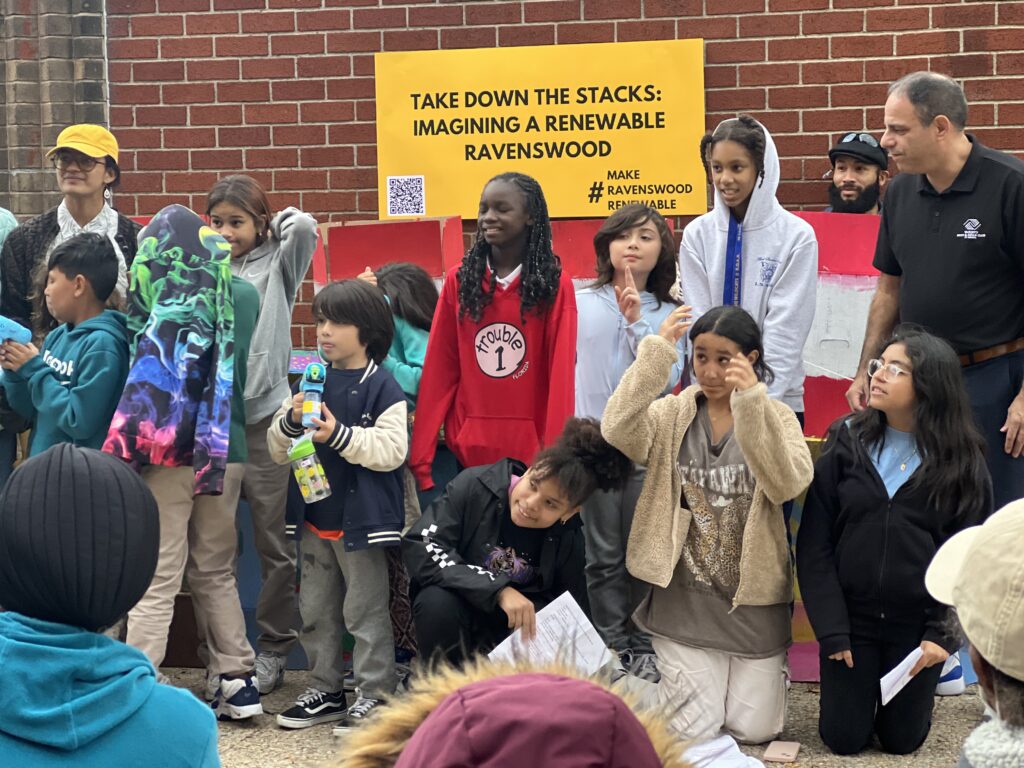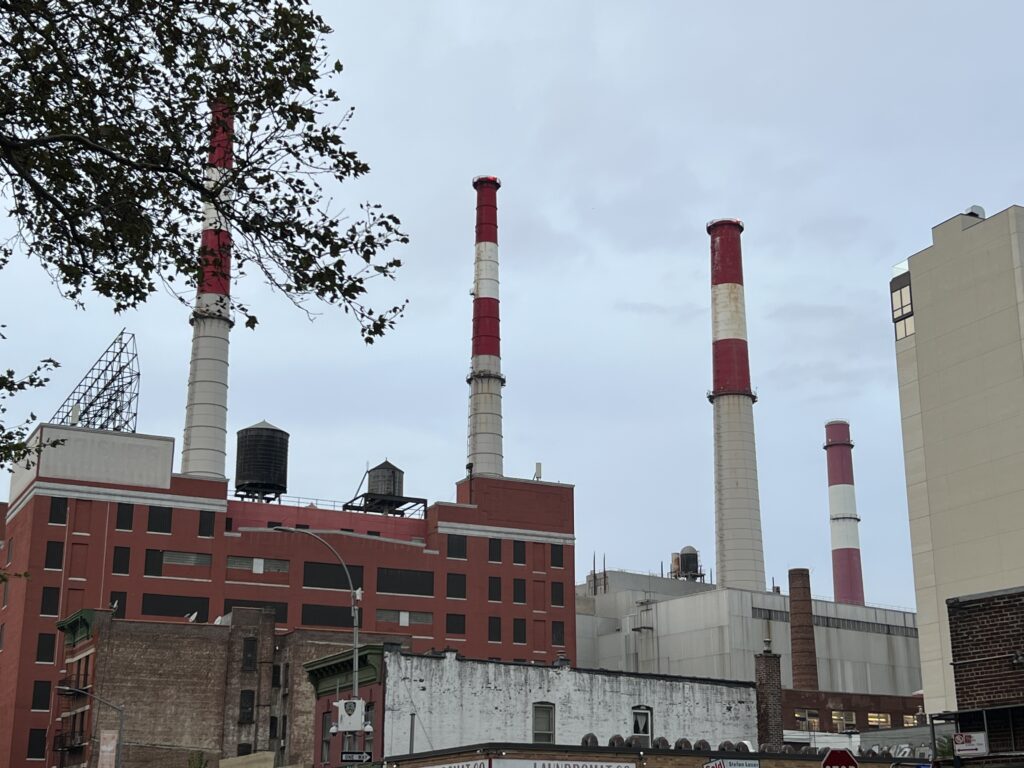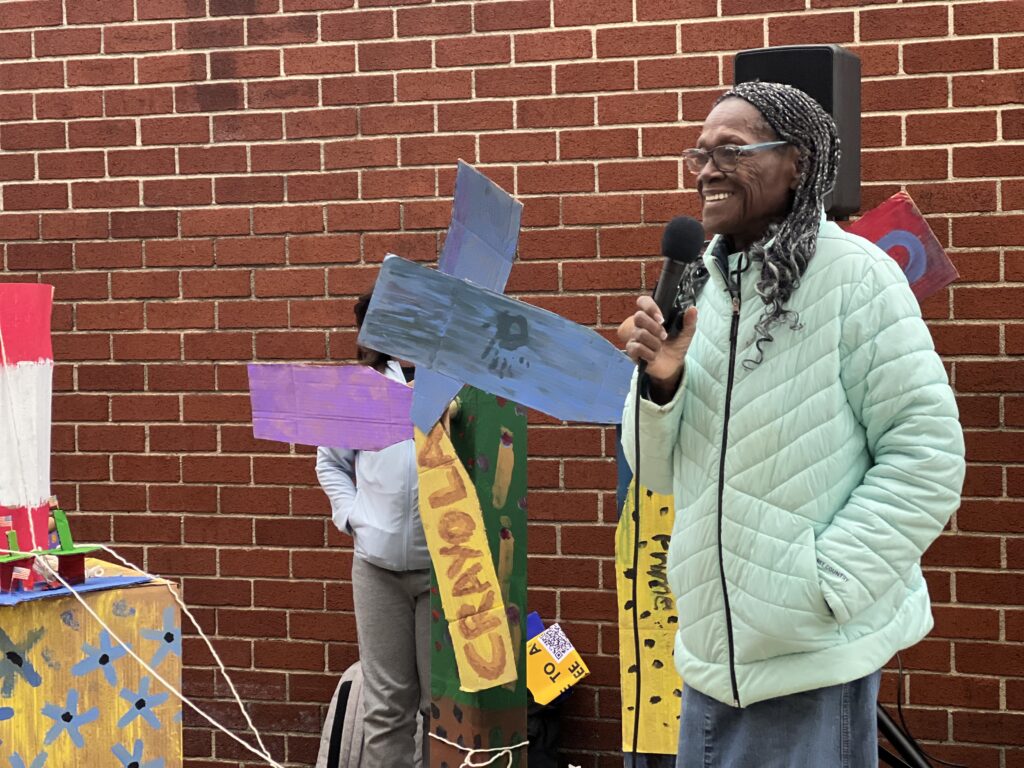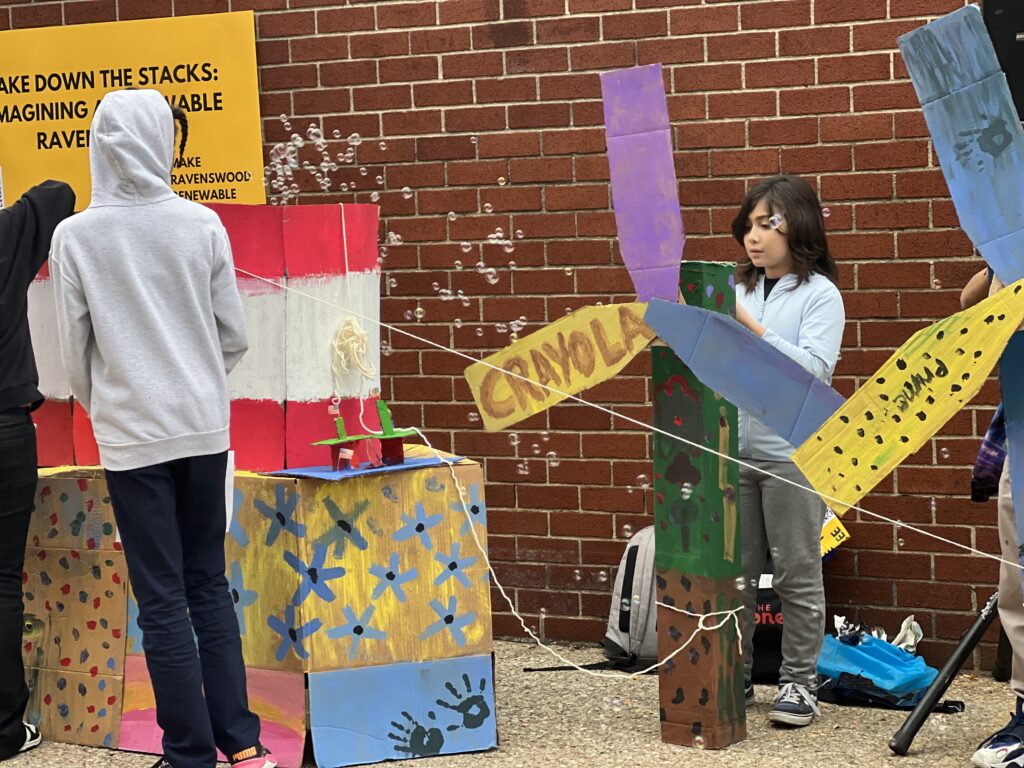By Celia Bernhardt | cbernhardt@queensledger.com
Editor’s note: Right at press time on Tuesday, news broke that Ravenswood’s Attentive Energy One was selected by NYSERDA to receive the investment that Renewable Ravenswood, Take Down the Stacks, and their partners have been advocating for.
On a windy, overcast Thursday afternoon, children, seniors, community leaders and activists gathered together in front of Ravenswood smoke stacks to protest the power plant’s detrimental health effects and demand a clean energy solution.
Elementary and middle school students hailing from Ravenswood, Astoria, and Queensbridge NYCHA Houses presented an extravagant art project to the crowd: painted cardboard models of the Ravenswood smoke stacks, along with an alternative energy source, wind turbines. The Variety Boys and Girls Club, in collaboration with grassroots community organization Take Down the Stacks, had the kids work with Astoria-based artist Ann Treesa Joy to build the project and prepare a speech.
“For the last two weeks, we’ve been working on building this model of recycled cardboard,” one student said to the crowd. “It’s a model of the power plant behind us. It’s called Ravenwood, and it took us about ten days to make it. But people in this neighborhood have been talking about taking down the plant for ten years.”
“It’s not fair that we kids in Astoria have to live with this air when the same kids across the river in Manhattan don’t,” said another student, as bubbles began to float up from the cardboard stacks, blown by children crouching behind the project. “We deserve clean air, clean lungs, and we demand Governor Hochul help.”
At the end of the speech, the students led a chant: “Take down the stacks, and give us our lives back!” Meanwhile, kids behind the cardboard wind turbines on either end of the stacks began to spin their panels.

Joy, Constantinides, and kids. Photo Credit: Celia Bernhardt
The Ravenswood Generating Station was installed in the early 1960s, next to the cluster of public housing that includes Astoria, Ravenswood, and Queensbridge Houses. It accounts for over 20% of the city’s generating capacity. It also increases air pollution in its immediate surroundings significantly, leading to much higher than average asthma rates among public housing residents who live closest to it; the area has even been dubbed “asthma alley” by advocates.
Rise Light & Power, the corporation which owns Ravenswood, is fully on board with converting the plant to green energy. Together with companies Total Energies and Corio, Rise Light & Power created a joint venture development corporation named Attentive Energy One, which would build wind turbines out in the Atlantic ocean. This wind power, along with other initiatives such as large-scale battery storage and upstate wind and solar energy, would replace the natural gas smoke stacks as Ravenswood’s source of energy.
A critical moment for the plan is upcoming: the New York State Energy Research and Development Authority is planning to select who, from a pool of six applicants in their “competitive offshore wind solicitation program,” will receive state investment. The decision, largely understood to be in Governor Hochul’s hands, is expected in autumn or winter of 2023.
Rise Light & Power now operates the “Renewable Ravenswood” initiative, which engages the community on the issue and gathers broader public support.
“Take Down the Stacks,” a grassroots organization which also works to engage the local community in the issue, worked with the Variety Boys and Girls club to pull off the art-based programming and rally.

Ravenswood Smoke Stacks. Photo credit: Celia Bernhardt
Noel Merritt, a 56 year old lifelong resident of Queensbridge Houses, spoke at the rally about his experience growing up in a community deeply affected by the pollution.
“Those toxins, they affected us as we grew up, you understand? Some of us didn’t reach our full growth potential, some of us had medical ailments. We have children who were born with disabilities from inhaling those toxins. One of the things that inhaling those toxins did to quite a few people in this community was affect their mental frame of mind. Not to say that it made them do anything out of the ordinary, but it created a chemical imbalance where they had issues that were neurological, as opposed to physical.”
Claudia Coger, an 88-year old resident of Astoria Houses, also spoke, illustrating the wide-reaching effects of the health issues correlated with the stacks.
“We have children that miss at least 30 days out of school every year,” Coger said. “That affects their education, that affects the families, the parents—a lot of parents have to miss days from work just to tend to their children. Not only that, there’s co-pays that go with all medications, and that becomes a burden on people’s budget. In my household, I have one granddaughter and two great grandchildren. And all three of them suffered with asthma so much so that the machines that they use had a copay of $500 each. And they could not share them. They had to have individuals, that was the doctor’s orders.

Coger addresses the crowd. Photo credit: Celia Bernhardt
“Just to be able to talk about it, it brings tears to my eyes,” Coger said, “because I saw them suffer. But I’m so glad to stand here with you young people today getting the knowledge of the air that you breathe.”
Nationwide, public housing is disproportionately likely to be located close to toxic pollution sites. Advocates say that the Ravenswood Stacks’ proximity to public housing, where most residents are lower-income Black and Brown New Yorkers, is an example of environmental racism in action.
Costa Constantinides, CEO of the Variety Boys and Girls Club and former city council member for the area, said that the state’s Climate Leadership and Community Protection Act provides even more basis for the Hochul to select Ravenswood for conversion.
“If the CLCPA, which is the state law that requires us to be 70% renewable energy by 2030, says that disadvantaged communities need to get 35% of the benefits from the energy revolution—if this isn’t what qualifies for a disadvantaged community that’s been impacted by fossil fuel infrastructure, then they could just pack it in and say that we’re not going to follow the law. Because this hits every criteria.”

Photo credit: Celia Bernhardt
Joy, a 28 year old artist from Astoria, led the kids in the two-week project. They reflected on the experience fondly.
“It was very chaotic, but it was really fun. We painted a bunch, we hot glued all the stuff together,” Joy said.
At first, they explained, the kids didn’t know many specifics about the stacks except that they were bad. “Of course, a lot of them also have asthma and have family members that have asthma, and so they know the consequences of that as well. And so they were able to piece together everything in a way that was like, oh, yeah, we don’t want this—which is really beautiful.”
“I love this generation,” Joy added. “They are so with it in a way that I never was at their age. I’m really impressed, and sad, that they have to be like this.”





